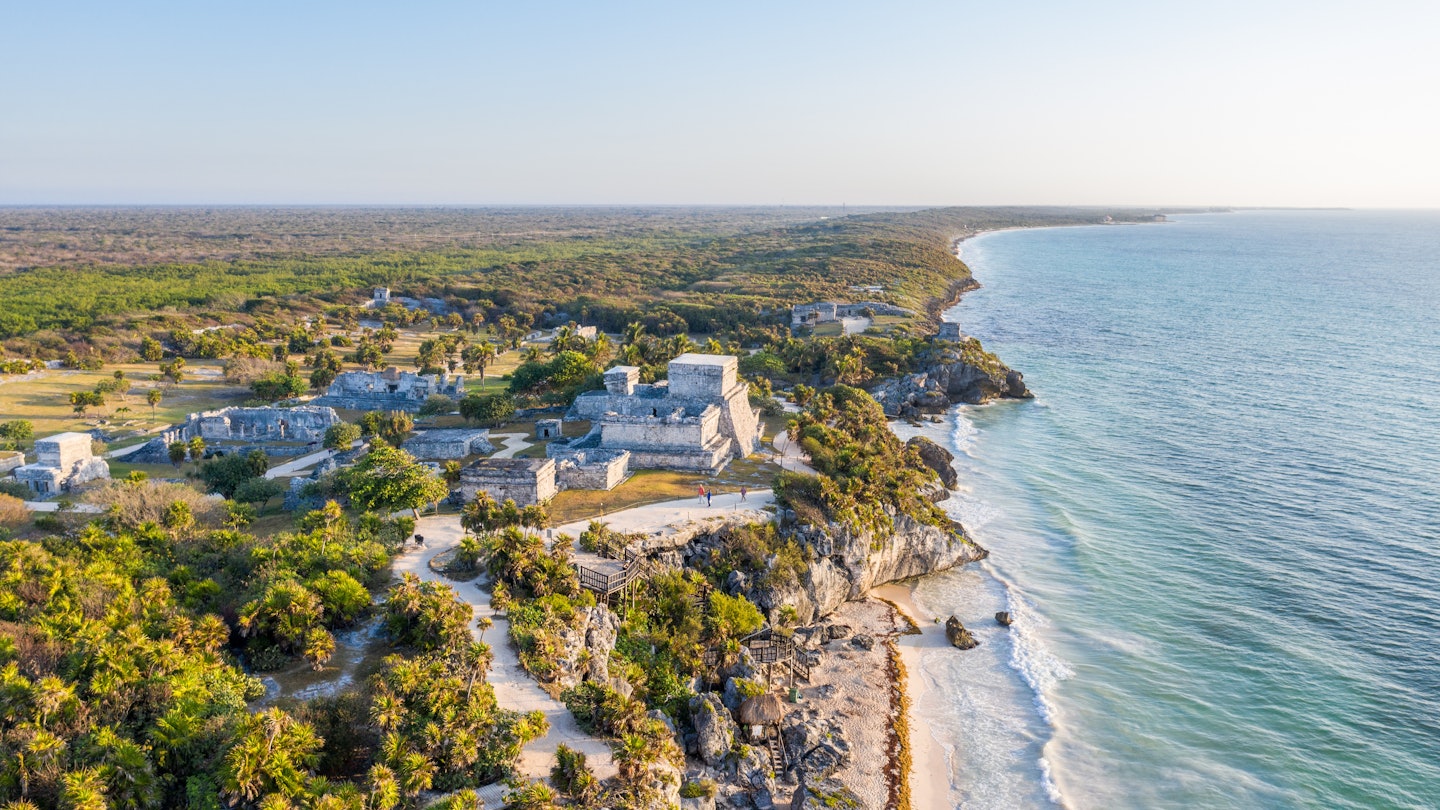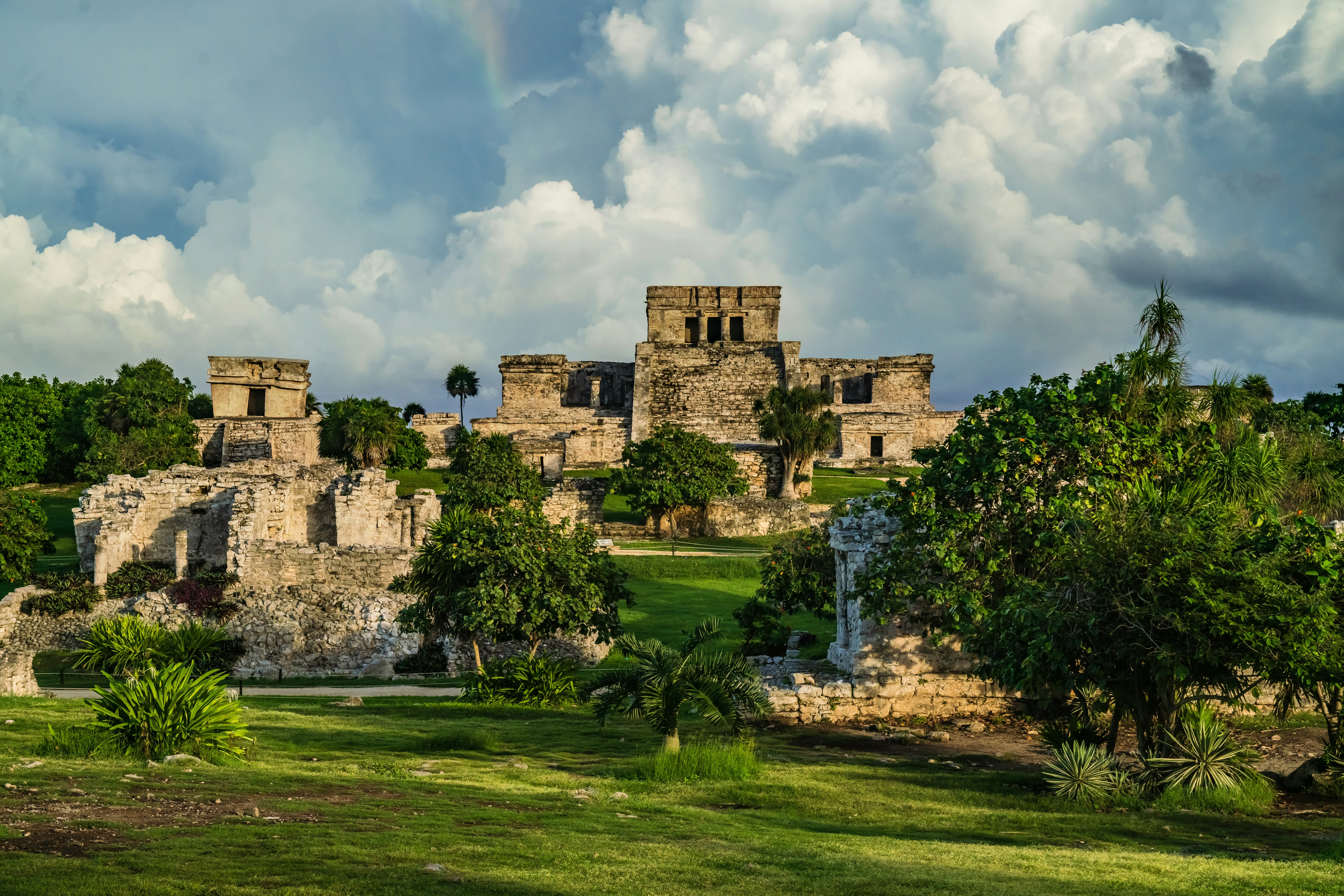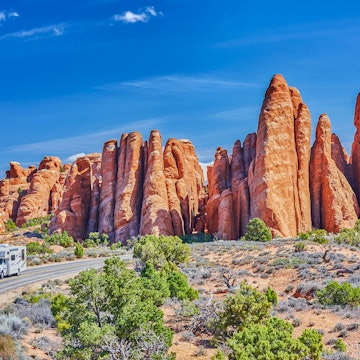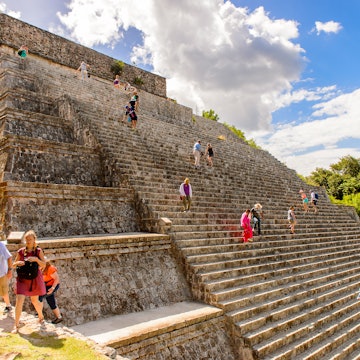
A first-time guide to Parque del Jaguar, the new reserve in Tulum, Mexico

Apr 29, 2025 • 8 min read

El Castillo and Tulum Ruins archaeological zone, Mexico. swissmediavision/Getty Images
Years in the making, the Parque del Jaguar is a newly created reserve in Tulum that encompasses protected beaches, lookout towers, forest trails and a museum full of Maya artifacts. The big draw is the archaeological zone, with its collection of temples and pre-Hispanic monuments. Though lacking the grandeur of Chichén Itzá, no other archaeological site in Mexico offers such stunning vistas over the Caribbean.
How much does it cost to visit Parque del Jaguar?
Admission to the park is M$350 (around US$17), though you’ll have to pay an extra M$100 (US$5) to visit the ruins – well worth it, since this is the chief draw of the park. Admission is free for children under the age of 12.
What are the opening hours for Parque del Jaguar?
The park’s beach access, its trails and viewpoints are open daily from 8am to 6pm. The museum and the ruins open from 9am to 3:30pm.

How do you get to Parque del Jaguar?
The main entrance to Parque del Jaguar is around 3km (1.9 miles) east of Tulum town. The park is located on both sides of the highway (Hwy 307). Most visitors enter the park near the ruins (on the south side of the highway – turn right if you’re driving here from Tulum), though you can also head straight to the museum, the trails and the lookout tower, which is north of the highway (turn left coming from Tulum).
If you’re driving, you’ll also have to pay for parking, which runs M$100 to M$200 (US$5 to US$10). The lots closer to the ruins charge more. Alternatively, rent a bicycle in town and ride out. A bike lane, separate from traffic, goes straight out to the park. It’s also handy to have a bicycle to get around within the park.
You can also reach the park by colectivo (shared van). These run from Tulum to Playa del Carmen and beyond. They pass by every 10 minutes or so, and you can flag one down and hop in, telling the driver you’re going to las ruinas (the ruins). Pay when you exit – around M$30 (US$1.50).
What’s the best way to get around Parque del Jaguar?
The park is too spread out to explore on foot; instead there’s free transportation on carros electricos (electric-powered open-sided vehicles) that make stops at key places of interest. You can also get around by bicycle, which gives you more freedom for moving about.

What should I see at the Tulum Ruins?
After paying your admission, head straight to the ruins (you can visit the beach and other site later). As you work your way around, be sure not miss the following highlights.
El Castillo
Standing nearly 8m-high (26ft) near the cliff face, this imposing structure once served as a lighthouse that guided Maya ships to port. In the upper level, note the small windows, which would blaze with light when fires were lit in the evening. The watchtower was appropriately named El Castillo (the Castle) by the Spaniards. Note the Toltec-style Kukulcánes (plumed serpents) at the corners, echoing those at Chichén Itzá.
Templo del Dios Descendente
This temple gets its name from a relief figure of a Descending God depicted in a niche above the building's door. The figure's legs are splayed, with his arms below and his face appearing beneath a headdress. His hands are holding an unknown object. Note the slightly off-kilter slope of the walls and door, which was created intentionally by Maya builders.
Casa del Cenote
Named for the small water-filled sinkhole at its southern base, the Casa del Cenote was built atop a vital water source for the city. Peer inside and down into the depths, and you might catch a glimpse of little silvery fish as they turn sideways in the murky water. A small tomb was found in the casa. The Maya believed cenotes were gateways to Xibalbá (the underworld).

Templo de las Pinturas
With its columns, carvings and two-story construction, the Templo de las Pinturas (aka Temple of the Frescoes) was among the most elaborate at Tulum. The facade on the lower temple has relief masks and sculptures, while colored murals reside on an inner wall. The murals have been partially restored but are nearly impossible to make out. This monument might have been the last built by the Maya before the Spanish conquest.
Templo del Dios Viento
All on its own on a high point overlooking the sea, this two-level structure is unusual for its round base, which is associated with Kukulcán, the Maya god of the wind. There’s a small altar within and evidence that the building was used for ceremonial purposes as late as the early 1900s. According to legend, when a whistling sound emitted from the upper story of the building, Maya knew dangerous storms and hurricanes were approaching, and they knew to take shelter.
Casa del Halach Uinic
A short walk from the Templo de las Pinturas, the House of the Halach Uinic is named after the royal lord (and high priest) who likely lived here. Though part of the sizable building is in ruins, you can still make out the staircase leading up to the column-lined entrance and a stucco image above the portal just beyond. It is yet another recurring image of the Descending God, which may relate to Ah Muzen Cab, the revered god of the bees.
Mirador Arqueoastronómico
Not marked on most maps is a fantastic viewpoint overlooking the ruins. Get there by turning right after passing the Temple of the Frescoes and heading west (inland) to an open expanse where you’ll have a sweeping view over El Castillo and the surrounding temples. A small sign points out the perfect alignment of the buildings in relation to solstices and equinoxes. At sunrise during the winter solstice, sunbeams stream through an opening in the top of the Templo del Dios Descendente.

What is there to see beyond the ruins?
Beaches and boat trips
Parque del Jaguar protects some lovely stretches of sand. A short distance past the ruins, you’ll reach the Faro de Tulum, a reconstruction of an ancient lighthouse. There’s a nice view over the shore, or you can take the path down to the beach. Once on the sand, stroll another 1.5km (0.9 miles) south, where you’ll reach Playa Mangle, with a rocky shoreline further along. There are other access points to the shore, including popular Playa Pescadores. Once on the beach, several restaurants dole out seafood and drinks, and rent out loungers and sunshades. Boat tours depart right from the beach. These cost around M$300 (US$15) for a one-hour tour that takes in views of the ruins from the water and includes a snorkeling stop; 90-minute tours run M$500 (US$25) and typically stop at two different spots for snorkeling. These run throughout the day from about 9am to 4pm.
Museo Regional de la Costa Oriental
This small museum has two sunlit rooms of Maya artifacts. A mix of original pieces and reproductions shed light on mythology, cultural practices, astronomy and the Maya calendar. Among the displays are fine stone carvings, jade jewelry and architectural masks.
Torre de Avistamiento
Around 800m (0.5 miles) from the museum, the Torre de Avistamiento (Observation Tower) offers intriguing views from a circular open-topped deck 10m (32ft) above the ground. Panels in English and Spanish point out Maya navigational strategies, unique architectural elements and insight into the region’s plant and animal life.
Walking trails
Between the Observation Tower and the museum, the 700m (0.4-mile) Aguadas walking trail takes you through forest to a small section of wetlands. North of the museum are several other spots for a walk: the 1.4km (0.9-mile) South Jungle Trail and the 0.95km (0.6-mile) North Jungle Trail. Go in the morning for the best chance to see birds, including social flycatchers, tropical kingbirds and great kiskadees.
What’s the history of pre-Hispanic Tulum?
Most archaeologists believe that Tulum was occupied during the late post-Classic period (1200–1521 CE) and that it was an important port town during its heyday. The Maya sailed up and down this coast, maintaining trading routes all the way down into Belize. When Juan de Grijalva sailed past in 1518, he was amazed by the sight of the walled city, its buildings painted a gleaming red, blue and yellow and a ceremonial fire flaming atop its seaside watchtower.
The ramparts that surround three sides of Tulum (the fourth side being the sea) leave little question as to its strategic function as a fortress. Several meters thick and 3m to 5m (9ft to 16ft) high, the walls protected the city during a period of considerable strife between Maya city-states. Not all of Tulum was situated within the walls. The vast majority of the city’s residents lived outside them; the civic-ceremonial buildings and palaces likely housed Tulum’s ruling class.
The city was abandoned about 75 years after the Spanish conquest. It was one of the last of the ancient cities to be abandoned; most others had been given back to nature long before the arrival of the Spanish. But Maya pilgrims continued to visit over the years, and indigenous refugees from the War of the Castes took shelter here from time to time.
This content is adapted from Lonely Planet's Mexico guide.















